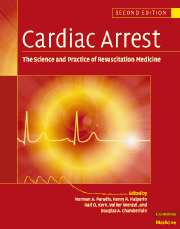Book contents
- Frontmatter
- Contents
- List of contributors
- Foreword
- Preface
- Part I Introduction
- Part II Basic science
- Part III The pathophysiology of global ischemia and reperfusion
- Part IV Therapy of sudden death
- 23 Prevention of sudden cardiac death
- 24 Sequence of therapies during resuscitation: application of CPR
- 25 Transthoracic defibrillation
- 26 Automated external defibrillators
- 27 Public access defibrillation
- 28 The physiology of ventilation during cardiac arrest and other low blood flow states
- 29 Airway techniques and airway devices
- 30 Manual cardiopulmonary resuscitation techniques
- 31 Mechanical devices for cardiopulmonary resuscitation
- 32 Invasive reperfusion techniques
- 33 Routes of drug administration
- 34 Adrenergic agonists
- 35 Vasopressin and other non-adrenergic vasopressors
- 36 Antiarrhythmic therapy during cardiac arrest and resuscitation
- 37 Acid–base considerations and buffer therapy
- 38 Cardiac arrest resuscitation monitoring
- 39 Special considerations in the therapy of non-fibrillatory cardiac arrest
- 40 Cardiocerebral resuscitation: a new approach to out-of-hospital cardiac arrest
- 41 Thrombolysis during resuscitation from cardiac arrest
- 42 Percutaneous coronary intervention (PCI) after successful reestablishment of spontaneous circulation and during cardiopulmonary resuscitation
- 43 Emergency medical services systems and out-of-hospital cardiac arrest
- 44 In-hospital resuscitation
- 45 Complications of CPR
- 46 Bringing it all together: state-of-the-art therapy for cardiac arrest
- Part V Postresuscitation disease and its care
- Part VI Special resuscitation circumstances
- Part VII Special issues in resuscitation
- Index
28 - The physiology of ventilation during cardiac arrest and other low blood flow states
from Part IV - Therapy of sudden death
Published online by Cambridge University Press: 06 January 2010
- Frontmatter
- Contents
- List of contributors
- Foreword
- Preface
- Part I Introduction
- Part II Basic science
- Part III The pathophysiology of global ischemia and reperfusion
- Part IV Therapy of sudden death
- 23 Prevention of sudden cardiac death
- 24 Sequence of therapies during resuscitation: application of CPR
- 25 Transthoracic defibrillation
- 26 Automated external defibrillators
- 27 Public access defibrillation
- 28 The physiology of ventilation during cardiac arrest and other low blood flow states
- 29 Airway techniques and airway devices
- 30 Manual cardiopulmonary resuscitation techniques
- 31 Mechanical devices for cardiopulmonary resuscitation
- 32 Invasive reperfusion techniques
- 33 Routes of drug administration
- 34 Adrenergic agonists
- 35 Vasopressin and other non-adrenergic vasopressors
- 36 Antiarrhythmic therapy during cardiac arrest and resuscitation
- 37 Acid–base considerations and buffer therapy
- 38 Cardiac arrest resuscitation monitoring
- 39 Special considerations in the therapy of non-fibrillatory cardiac arrest
- 40 Cardiocerebral resuscitation: a new approach to out-of-hospital cardiac arrest
- 41 Thrombolysis during resuscitation from cardiac arrest
- 42 Percutaneous coronary intervention (PCI) after successful reestablishment of spontaneous circulation and during cardiopulmonary resuscitation
- 43 Emergency medical services systems and out-of-hospital cardiac arrest
- 44 In-hospital resuscitation
- 45 Complications of CPR
- 46 Bringing it all together: state-of-the-art therapy for cardiac arrest
- Part V Postresuscitation disease and its care
- Part VI Special resuscitation circumstances
- Part VII Special issues in resuscitation
- Index
Summary
Introduction
Ventilation – the movement of fresh air or other gas from the outside into the lungs and alveoli in close proximity to blood for the efficient exchange of gases – enriches blood with O2 and rids the body of CO2 by movement of alveolar gas out of the lungs to the outside.
The importance of ventilation in resuscitation is reflected in the “ABCs” (airway, breathing, circulation), which is the recommended sequence of resuscitation practiced in a broad spectrum of illnesses including traumatic injury, unconsciousness, and respiratory and cardiac arrest. Since the modern era of cardiopulmonary resuscitation (CPR) began in the early 1960s, ventilation of the lungs of a victim of cardiac arrest has been assumed to be important for successful resuscitation.
This assumption has been questioned and the role of ventilation during resuscitation has been the subject of much research for more than a decade. A number of laboratory studies of CPR have shown no clear benefit to ventilation during the early stages of cardiac arrest with ventricular fibrillation. Furthermore, exhaled gas contains approximately 4% CO2 and 17% O2, thus making mouth-to-mouth ventilation the only circumstance in which a hypoxic and hypercarbic gas mixture is given as recommended therapy. With the introduction of the 2000 Guidelines for Cardiopulmonary Resuscitation, a new, evidence-based approach to the science of ventilation during CPR was introduced and continues with the publication of the 2005 edition. New evidence from laboratory and clinical science has led to less emphasis being placed on the role of ventilation following a dysrhythmic cardiac arrest (arrest primarily resulting from a cardiovascular event, such as ventricular fibrillation or asystole).
- Type
- Chapter
- Information
- Cardiac ArrestThe Science and Practice of Resuscitation Medicine, pp. 506 - 549Publisher: Cambridge University PressPrint publication year: 2007

